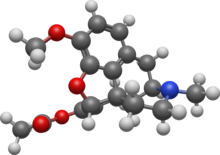Thebacon
This articleneeds additional citations forverification.(October 2021) |
This articleneeds morereliable medical referencesforverificationor relies too heavily onprimary sources.(October 2021) |  |
 | |
 | |
| Clinical data | |
|---|---|
| AHFS/Drugs.com | International Drug Names |
| ATC code | |
| Legal status | |
| Legal status |
|
| Identifiers | |
| |
| CAS Number | |
| PubChemCID | |
| ChemSpider | |
| UNII | |
| KEGG | |
| ChEMBL | |
| CompTox Dashboard(EPA) | |
| ECHA InfoCard | 100.006.708 |
| Chemical and physical data | |
| Formula | C20H23NO4 |
| Molar mass | 341.407g·mol−1 |
| 3D model (JSmol) | |
| |
| |
Thebacon(INN;[2]pronounced/ˈθiːbəkɒn/), ordihydrocodeinone enol acetate,is asemisyntheticopioidthat is similar tohydrocodoneand is most commonly synthesised fromthebaine.Thebacon was invented inGermanyin 1924, four years after the first synthesis of hydrocodone.[3]Thebacon is a derivative ofacetyldihydrocodeine,where only the 6–7double bondis saturated. Thebacon is marketed as itshydrochloride saltunder the trade nameAcedicon,and as itsbitartrateunderDiacodinand other trade names. The hydrochloride salt has afree baseconversion ratio of 0.846. Other salts used in research and other settings include thebacon's phosphate, hydrobromide, citrate, hydroiodide, and sulfate.
Medical uses[edit]
Thebacon is anopioidagonistnarcoticanalgesicof the middle range and a strongantitussive,primarily used inEurope,although it is no longer in common use.[citation needed]Currently,dihydrocodeineandnicocodeineare used assecond-linecodeinereplacements. The other dihydromorphinone used as an antitussive is hydromorphone (Dilaudid cough syrup); the other narcotic antitussives are either more directly related to codeine or not related at all (open chainmethadonerelatives andthiambutenes).
Thebacon is indicated for moderate to moderately severe pain and dry painful coughing, like hydrocodone. It has a duration of action in the range of 5 to 9 hours and doses typically start at 5 mgq6h.For both pain and coughing, thebacon can be made more effective along withNSAIDs,muscle relaxants,and/orantihistaminesliketripelennamine,hydroxyzine,promethazine,phenyltoloxamineandchlorpheniramine.[medical citation needed]
Pharmacokinetics[edit]
Thebacon is most commonly taken orally as an elixir, tablet, or capsule, although rectal andsubcutaneousadministration has the same advantages[according to whom?]with hydrocodone as would taking a tablet, powder, or a liquid concentratebuccallyorsublingually.Like all of its chemical relatives in this class (codeine-based semi-synthetic narcotic antitussives), thebacon exerts its analgesic effect and a large part of its antitussive andantiperistalticaction as aprodrugfor stronger and/or longer-lasting opioids, primarilyhydromorphone,which is formed in the liver by thecytochrome P450 2D6(CYP2D6) enzyme pathway as well asacetylmorphone.As a result, the effectiveness of a given dose of thebacon will vary amongst patients, and some food and drugs can affect various parts of theliberation, absorption, distribution, metabolism and elimination profile,and therefore a variable proportion of the potency of thebacon. Thebacon can be said to be the 6-monoacetylmorphine analog of hydrocodone, and/or the6-acetylmorphoneanalog ofcodeine.It is also a close structural relative of3,14-diacetyloxymorphone.
Thebacon'sanalgesicand antitussive potency is slightly higher than that of its parent compoundhydrocodone,which gives it approximately eight times the milligram strength of codeine. The acetylation at position 3 and the conversion into a dihydromorphinone class semisynthetic (at position 14 on the morphine carbon skeleton) allows for the drug to more rapidly enter the central nervous system in greater quantity where it is de-acetylated intohydromorphone,and also converted by other processes intohydromorphinol,morphineand various other active and inactive substances; it therefore simultaneously takes advantage of two methods of increasing the effectiveness of morphine and its derivatives, those being catalytic hydrogenation (codeine into hydrocodone) and esterification (morphine intodiamorphine,nicomorphine&c) in a manner not unlike to that ofdihydrodiacetylmorphine.
Production[edit]
Thebacon is generated by theesterificationproduct of theenoltautomerofhydrocodone(dihydrocodeineone) withacetic anhydride.[4]Although modification of thebaine is the most common way of making thebacon, preparation by refluxing hydrocodone withacetic anhydrideis not uncommon, generally similar to howdiacetylmorphineis produced. It is also a product of themetabolismof hydrocodone byPseudomonas putidaM10,the bacterium used for oil spill remediation. This also produces amorphinone reductase,which can turn morphine intohydromorphonein a process which produces other active opioids, such asoxymorphone,oxymorphol,orhydromorphinolas intermediates.
Legal status[edit]
Thebacon is aSchedule I controlled substancein the United States, never having been in medical use there.[5]The USDEAAdministrative Controlled Substance Control Number assigned by theControlled Substances Act(1970) for thebacon and all of its salts is 9315.[6]
See also[edit]
References[edit]
- ^Anvisa(2023-03-31)."RDC Nº 784 - Listas de Substâncias Entorpecentes, Psicotrópicas, Precursoras e Outras sob Controle Especial"[Collegiate Board Resolution No. 784 - Lists of Narcotic, Psychotropic, Precursor, and Other Substances under Special Control] (in Brazilian Portuguese).Diário Oficial da União(published 2023-04-04).Archivedfrom the original on 2023-08-03.Retrieved2023-08-16.
- ^Sweetman SC, ed. (2009).Martindale: The Complete Drug Reference(36th ed.). London: Pharmaceutical Press.ISBN978-0-85369-840-1.
- ^Reynolds AJ, Randall LO (1957).Morphine & Allied Drugs.Toronto: Princeton U Press.OCLC1628783.
- ^US 1731152,Schopf C, "Process for the manufacture of derivatives of dihydrocodeinone or its substitution products", assigned to Boehringer
- ^"Controlled Substance Schedules".US Department of Justice. Archived fromthe originalon 7 February 2011.
- ^"Lists of: Scheduling Actions Controlled Substances Regulated Chemicals"(PDF).Diversion Control Division.U.S. Drug Enforcement Administration. pp. 59, 75, 89.
